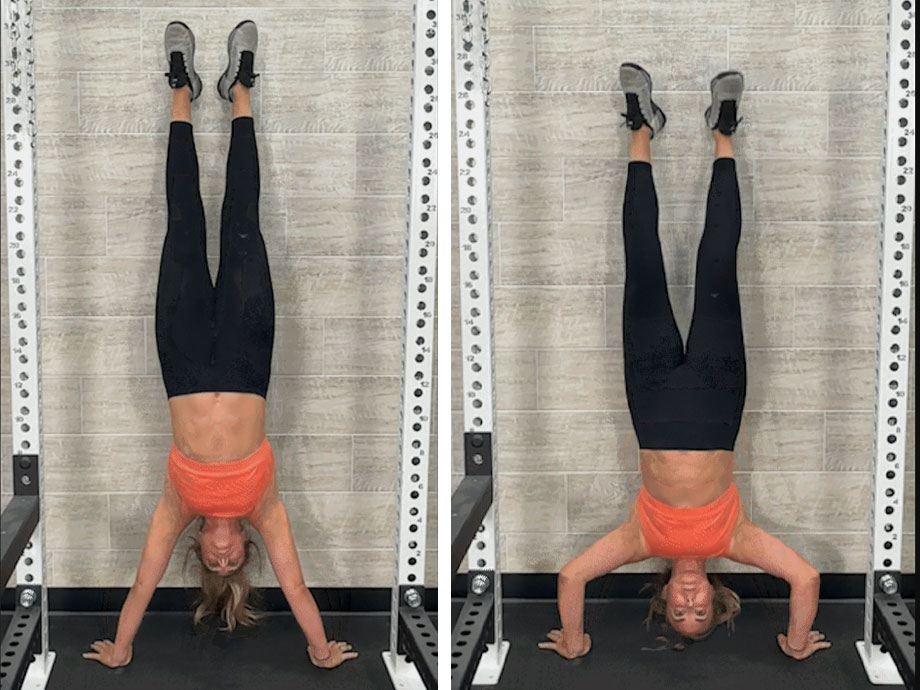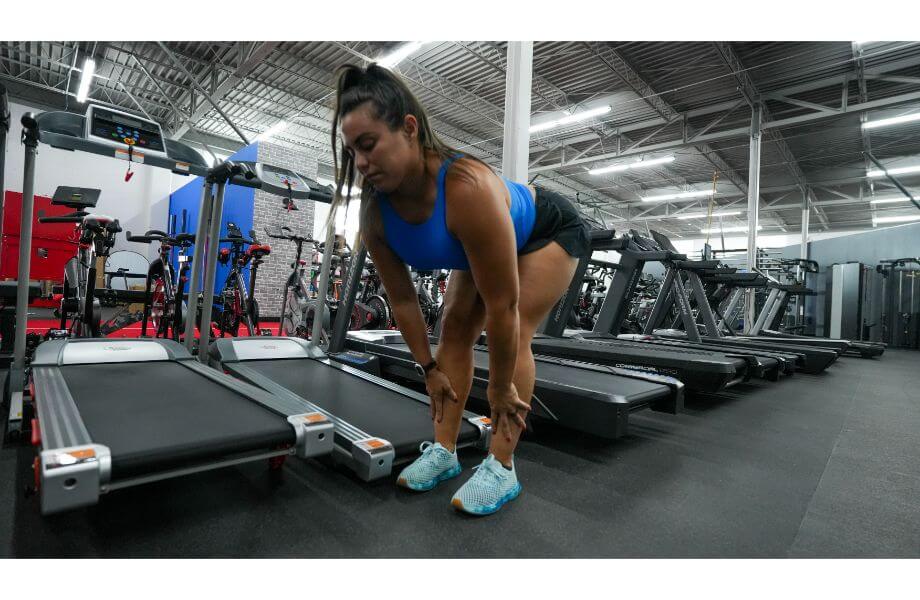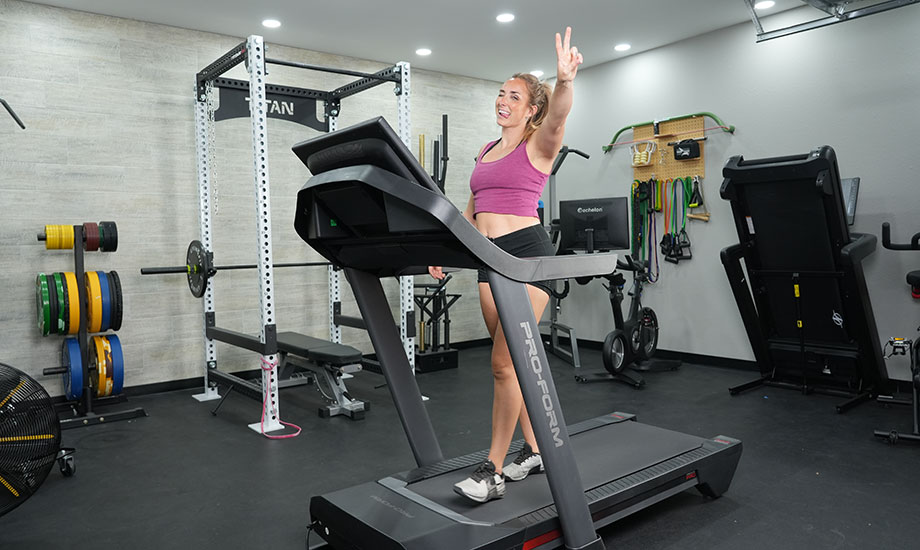Picture this: You’re at a party with one of your closest fitness buds. They’re talking about how CrossFit workouts have helped them gain some serious upper-body strength when suddenly they turn to face the wall, throw their hands on the floor, fling their feet in the air, and start doing handstand push-ups.
Sure, it’s a bit gauche to bust out unsolicited bodyweight exercises at a party; however, you can’t deny that you’re impressed at this unexpected feat of strength and can’t help but wonder what it takes to do handstand push-ups, the benefits they offer, and if maybe you can learn them and start wowing your friends at the next get-together.
Well, you’re in luck: we’ve got Kate Meier, NASM-CPT, USAW-L1, CF-L1, and GGR editorial team member, with the ultimate guide for everything handstand push-ups, including how to do them, why you should do them, and more!
Get ready to have your world turned upside down because we’re goin’ in 3…2…1…
How To Do Handstand Push-Ups
The handstand push-up (HSPU) requires upper-body strength and technique, so you’ll want to build a strong foundation before you attempt full handstand push-ups. Stick to high-rep sets of regular push-ups and isometric handstand holds first to build muscle and get familiar with the feeling of being upside down.
Once you’re good here, get ready to go head over heels with these simple steps.
How to do it:
- Place your hands shoulder-width apart on the floor so they’re roughly 6 to 12 inches from the wall, then kick your feet up and over until they come to rest against the wall.
- Tighten your core and relax your head and neck.
- Slowly bend your elbows to lower the crown of your head toward the ground.
- Continue until your head lightly touches the floor or a handstand push-up pad.
- Pause, then extend your elbows to push yourself back to the starting position.
- Repeat for reps.
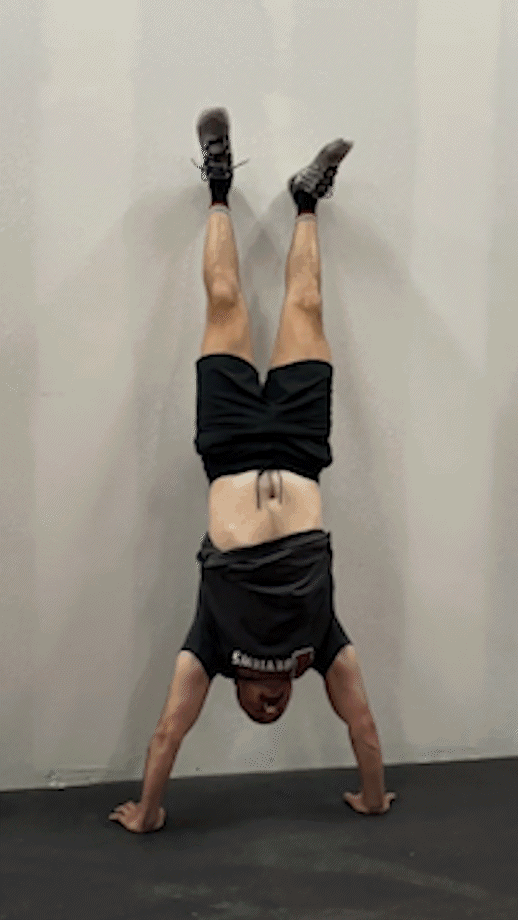
Modifications
- Dial it back: Handstand push-ups look hard, but they’re totally doable with the right approach. Work on your standard push-ups, pike push-ups, wall walks, and handstand holds first to build strength, muscle, and confidence before trying the real deal.
- Make it harder: You’re well-acquainted with HSPU, and your form is impeccable, so what’s the next step? Lose the wall, champ; try freestanding handstand push-ups or handstand walks to take your handstand game to the next level.
How To Do Handstand Push-Ups At Home
One of the best things about calisthenics and bodyweight exercises is you need no equipment whatsoever to get the job done, so the handstand push-up is the perfect exercise for building upper body strength at home. All you need is a free wall for your feet, and you are good to go!
RELATED: At-Home Bodyweight Workout
Handstand Push-Up Variations
- Deficit handstand push-up: Propping your hands on some bumper plates or using a pair of parallettes turns your HSPU into deficit handstand push-ups, increasing the range of motion and making each rep pack more punch!
- Kipping handstand push-up: Strict handstand push-ups require upper body strength in spades, meaning high-rep sets of HSPU will annihilate even the most elite athletes. So, CrossFit competitors perform kipping HSPU instead, recruiting their lower bodies to help cycle reps quicker and conserve the energy needed to complete even the most grueling WODs.
- Handstand hold: Converting your HSPU into isometric handstand holds helps you get comfortable being upside down while building the upper-body strength you’ll need to progress.
RELATED: Isometric Exercises
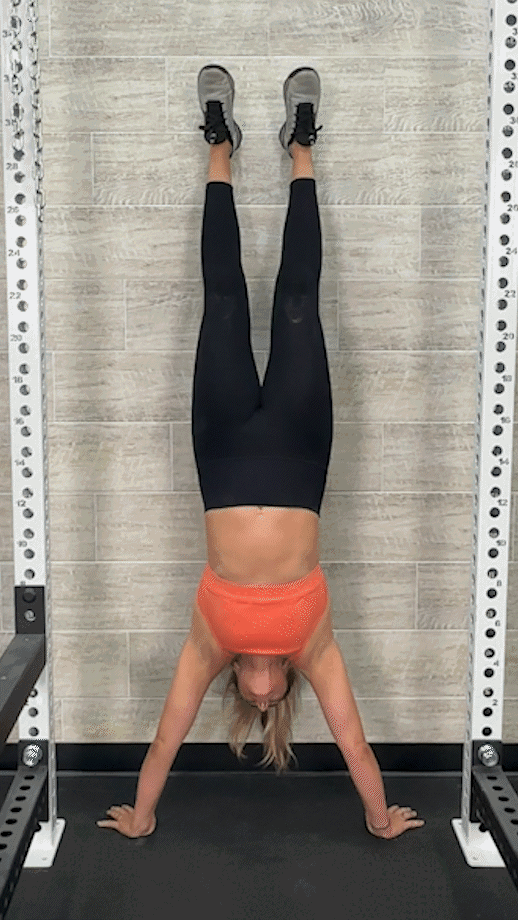
Handstand Push-Up Alternatives
Adding handstand push-ups into your workout routine unlocks one killer upper-body movement you can do virtually anywhere. That said, it’s not the only exercise that can build your shoulders and triceps as successfully.
Here are a few handstand push-up alternatives to help you flesh out your upper-body routine.
Wall Walk
Why do it: We know in our rational minds that the wall we’re staring down isn’t going anywhere, yet many of us balk when it’s time to commit, fearing that we’ll catastrophically fail and get hurt. Wall walks offer a considerably less scary alternative because instead of throwing your feet up and over, you’re slowly easing yourself into that handstand position.
How to do it:
- Start in a high plank position with your back to the wall.
- Slowly “walk” one hand at a time toward the wall while walking one foot up the wall.
- Continue until you’re in the handstand position.
- Pause, then walk your way back down to your starting position.
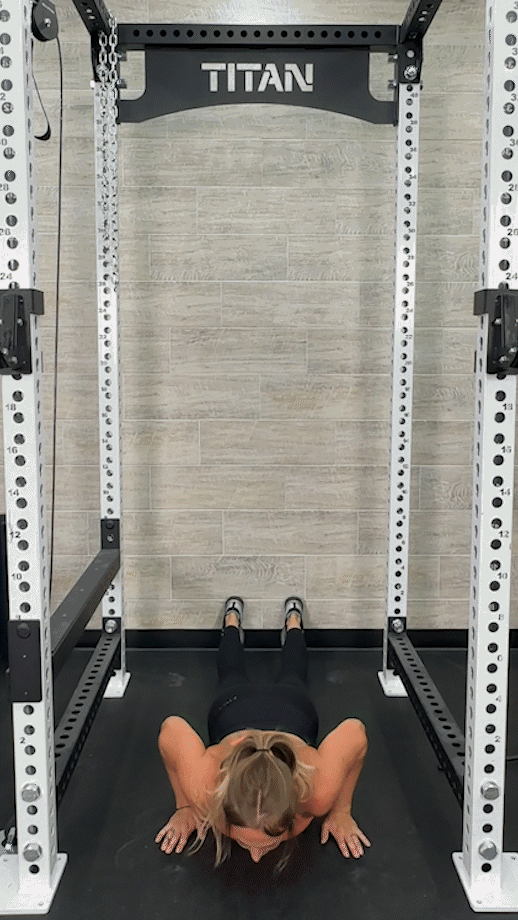
Z Press
Why do it: Instead of sitting on a nice, cushy weight bench, the Z press involves parking your caboose on the gym floor and pressing the barbell overhead with your legs fully extended. Thanks to this unique positioning, you’re essentially cutting your lower-body muscles out of the equation and shifting the full emphasis onto your shoulders, triceps, and core muscles.
How to do it:
- Set the J-cups of your squat stand or power rack to a low position.
- Rack your barbell, load it to your desired weight, and have a seat facing it.
- Unrack the bar in the front rack position, keeping your upper body tall, core tight, legs fully extended, and neck neutral.
- Press the barbell up until you reach full lockout.
- Squeeze the contraction, then slowly lower the barbell back down to the starting position.
- Repeat for reps, then rerack.
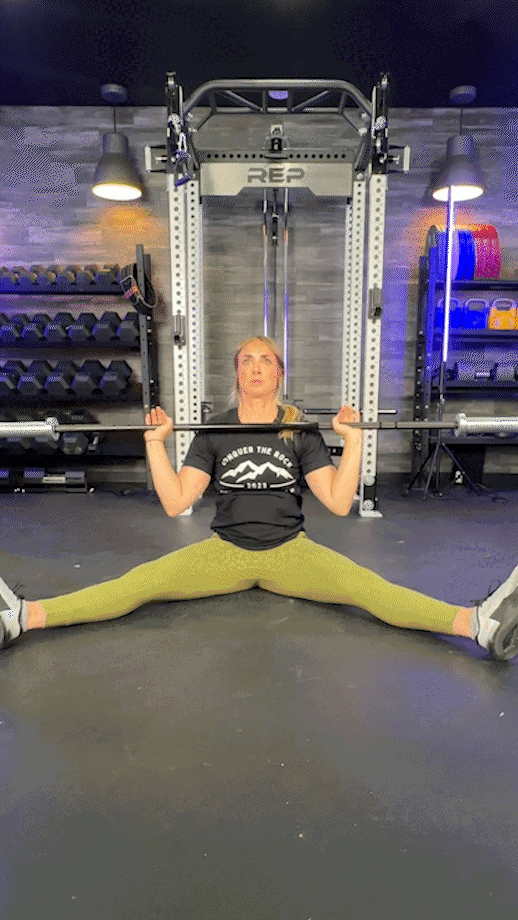
Incline Push-Up
Why do it: Standard push-ups help lay the groundwork that makes progressing to HSPUs more manageable, but beginners may struggle to do them with a full range of motion (while supporting their body weight). That’s where incline push-ups come in, as this push-up variation reduces your range of motion and lets your legs bear some of the brunt of your body weight to make things easier.
How to do it:
- Place your hands on a weight bench, plyometric box, countertop, or other stable surface.
- Step your feet back to enter an angled push-up position.
- Bend your elbows to lower your chest toward the surface, keeping your core and glutes engaged throughout the full range of motion.
- Pause, then push yourself back up to the starting position by extending your elbows.
- Repeat for reps.
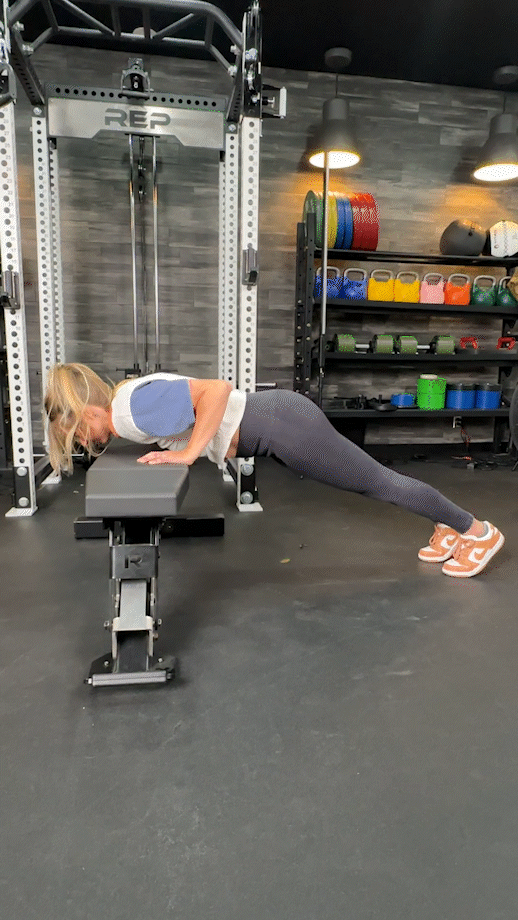
Decline Push-Up
Why do it: Whereas incline push-ups take the edge off, decline push-ups ramp up the intensity and make that range of motion even more intense. So, if vanilla push-ups are starting to feel too easy, spice things up by elevating your feet and adding a little decline.
How to do it:
- Place both feet on a bench, plyometric box, step-up platform, or other stable surface.
- Walk your hands out until you’re in an angled push-up position.
- Bend your elbows to lower your chest to the floor, keeping your core and glutes engaged throughout the full range of motion.
- Pause, then push yourself back to the starting position by extending your elbows.
- Repeat for reps.
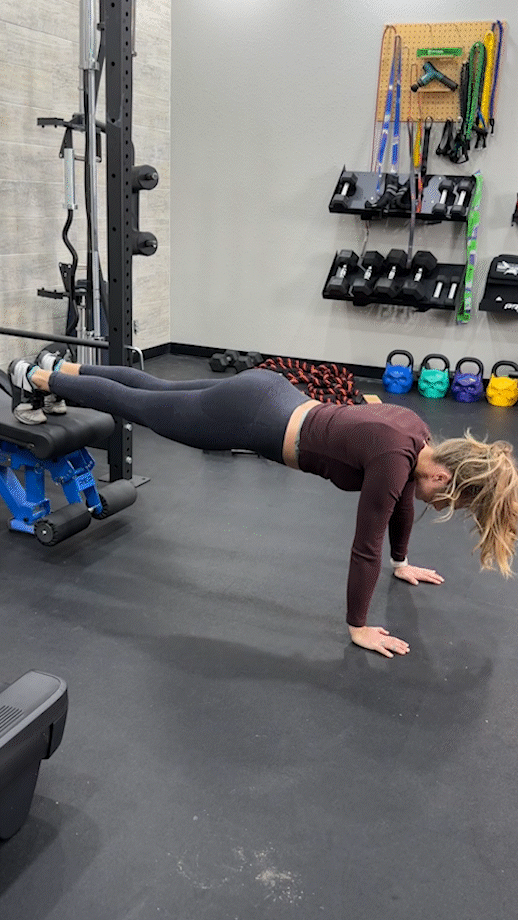
Pike Push-Up
Why do it: “Push-ups provide activation to your shoulders to some degree, but the emphasis is primarily on the chest and triceps,” says Kate Meier, NASM-CPT, USAW-L1, CF-L1. “Performing pike push-ups shifts that focus onto the deltoids and trapezius, which will be integral to learning and perfecting proper HSPU form.”
How to do it:
- Start from a high plank position with your hands shoulder-width apart.
- Raise your hips toward the ceiling, forming an upside-down “V” with your body.
- Bend your elbows to lower your upper body forward and down to the floor.
- Continue until your elbows are fully bent.
- Pause, then extend your elbows to return to the starting position.
- Repeat for reps.
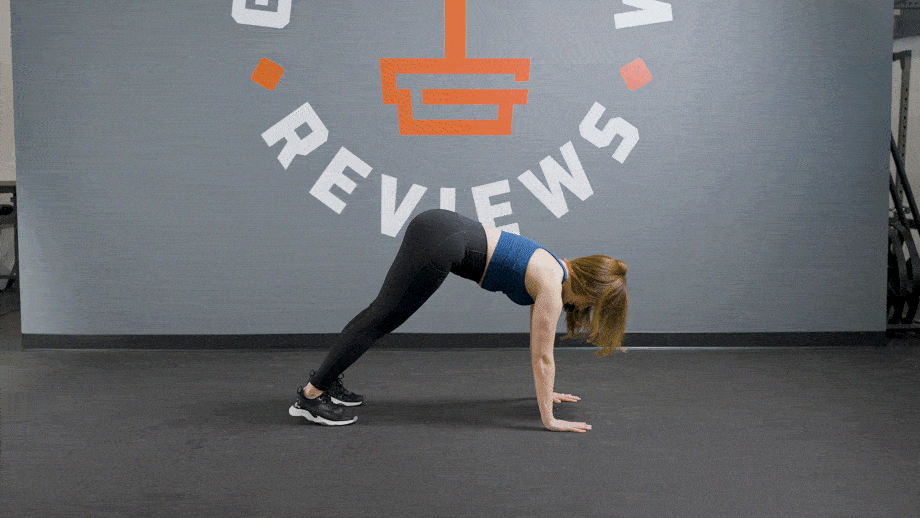
Benefits of Handstand Push-Ups
As we’ve established, you’ll look super cool if you whip out handstand push-ups at the next event you attend, but HSPUs are much more than a slick party trick. Here are a few of the top benefits of doing handstand push-ups.
Improves Upper-Body Strength
If you’re working out in a commercial gym or fully-kitted home gym, you probably have access to barbells, dumbbells, kettlebells—everything you need to build an upper body that would make bodybuilders weep. Now, if you don’t have access to this classic fitness equipment, things may be a little trickier.
RELATED: Best Dumbbells
That’s where handstand push-ups truly shine. You can get tons of upper body muscle activation with push-ups, pull-ups, and triceps dips, but no bodyweight exercise targets the shoulders with as much intensity as handstand push-ups.
Performing wall handstands, handstand push-ups, and handstand push-up variations increases shoulder strength, enhances shoulder mobility, and contributes to better overall shoulder health.
Better Joint Health
Handstands—whether or not you’re doing a push-up from that position—require many of your joints to work overtime by stabilizing your body so you don’t sway or tumble over. So, regularly doing handstands and/or handstand push-ups can help improve your joint health and increase joint stability.
A 2021 study in PLoS One1 observed this firsthand when they studied fifty-nine male gymnasts as they performed a straight-arm press to handstand. The study found that the more skilled gymnasts exhibited less sway when executing the movement, suggesting greater joint stability in their wrists, shoulders, and hips.
May Delay Aging
Studies show2 that regular exercise helps reduce or prevent many of the ill effects of aging, but handstands and handstand push-ups may offer a little more upside than other run-of-the-mill exercise programs.
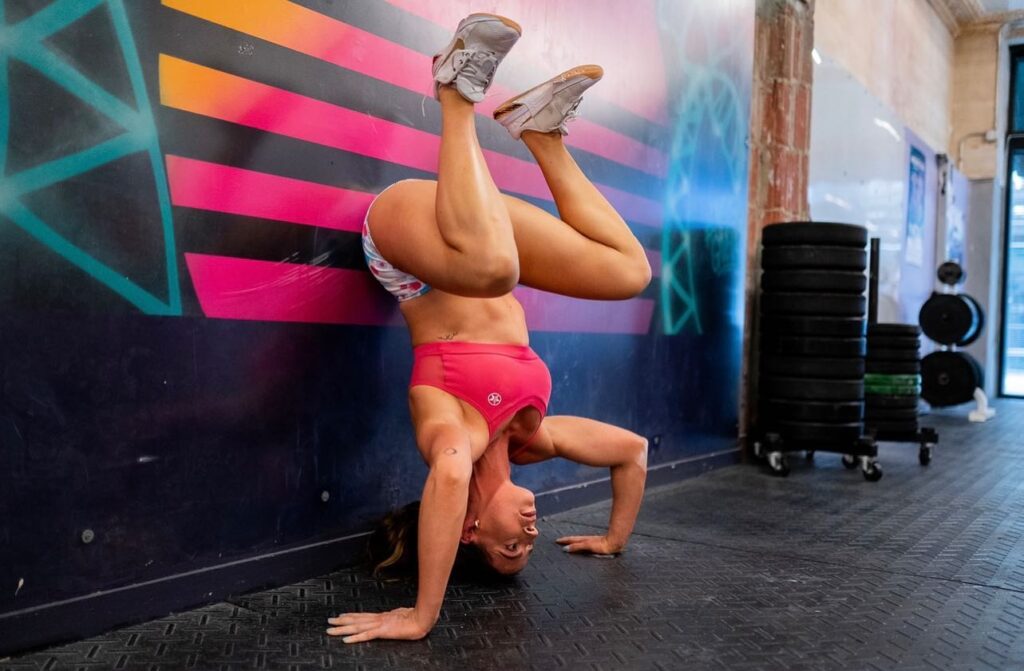
A 2022 case study published in Frontiers in Medicine3 investigated the physical effects of a test subject who practiced a passive handstand exercise regularly for 40 years. Researchers found that the subject’s cerebrovascular, spinal, and mental health were all excellent. In addition, they noted that “he appeared younger than his peers,” suggesting that “long-term passive handstand exercise can promote cerebrovascular elasticity training and delay signs of aging.”
Common Handstand Push-Up Mistakes
If you want to reap the most reward from mastering this intermediate bodyweight exercise, you best take the time to learn proper HSPU form and perform perfect reps every time. That’s right; half reps and reps with poor form don’t count around here, so here are a few common mistakes to avoid.
Holding Tension in Your Neck
Throwing yourself feet first at a wall is a gut check for many, so it’s natural to seize up and hold tension in our neck and shoulders as we get into position. Unfortunately, excess neck tension during your HSPU reps is a recipe for aches, pains, strains, and other bad things.
“Once you’re inverted, take a moment to check in with your form,” recommends Kate. “Tighten your core and take a few breaths before your first rep. Deep breaths help naturally release the tension from your neck and shoulders, protecting these key regions once you begin your set.”
Improper Hand Placement
Performing push-ups in a handstand position will feel super awkward the first time, but it’s going to feel worse if your hands aren’t in the right spot. Too far, and your biomechanics are off; too close, and your butt will literally hit the wall and push you away from it.
The sweet spot is approximately six to 12 inches from the wall. Don’t be afraid to experiment a bit to see what feels best for you. And, of course, don’t be shy about consulting a certified personal trainer or other qualified fitness professional if you want to make sure you’re getting your form locked in.
RELATED: Best Online Personal Trainer
Shortchanging Your Range of Motion
We told you: Half reps don’t count around here, so we don’t want you to bob up and down with the smallest, slightest elbow flex known to man and call that a rep. You want the full range of motion on each rep, descending until the crown of your head touches its target before pressing yourself back up to the starting position.
Of course, you don’t have to go all the way to the floor. It’s common to reduce the range of motion (ROM) in the beginning using bumper plates, ab mats, specialized handstand push-up pads, or even a stack of books. Just make sure you hit your target on each rep and reduce the height of the buffer as you progress.
Muscles Worked by Handstand Push-Ups
The handstand push-up is a compound exercise, so you’re activating a whole lotta muscles with each rep. The most significant muscles worked by the HSPU include the:
- Shoulders: The main muscles used for this bodyweight beast would be your shoulders or, more specifically, your deltoids. Your delts are responsible for various arm movements and stabilizing the shoulder joint, so you’d likely crumple to the floor if they didn’t do their thing during HSPUs.
- Triceps: While your shoulders hold the handstand position, your triceps enable elbow flexion and extension, making them the prime mover. You simply can’t perform push-ups without your triceps.
- Back: Your back muscles, namely the traps, lats, and rhomboids, are all working to hold a strong posture and prevent sway. Your shoulders get the lion’s share of activation, but your back is integral here, too.
- Core: Just as your abdominals protect your spine and help you maintain your posture during the barbell overhead press and other standing shoulder exercises, these muscles work to keep you in a strong position while doing HSPUs.
Handstand Push-Ups: Final Thoughts
Whether you’re an aspiring gymnast, a hopeful CrossFit Games competitor, or just an everyday person looking to build bigger, stronger shoulders without as much weightlifting, the handstand push-up is among the best bodyweight exercises at your disposal.
Handstand push-ups:
- Build upper-body strength and muscle
- Improve joint stability, mobility, and health
- Enhance proprioception and balance
- Require no equipment to perform
- May promote various health and wellness benefits
- May impress unsuspecting onlookers at social events
Listen—we know that handstand push-ups may seem daunting, but the upsides far outweigh the risks, and with our step-by-step instructions, top tips, and tutorials, you stand your best chance of success.
So, what are you waiting for? Give handstand push-ups a try during your next workout!
Handstand Push-Ups: FAQs
Are handstand push-ups effective?
Absolutely. Handstand push-ups, similar to regular push-ups, pull-ups, and muscle-ups, pit your own body weight against the force of gravity to produce major muscle activation and inspire some big-time strength and hypertrophy gains.
Do handstand push-ups still build your chest?
You won’t get as much muscle activation in your pectorals as the regular push-up or bench press, but the handstand push-up does hit your chest, specifically your upper chest, to some degree. So, yes, you can use HSPUs to build your chest, but it’s probably not the best exercise for that goal.
RELATED: Upper-Chest Workout
What difficulty level are handstand push-ups?
Handstand push-ups seem very advanced at a glance, but we would actually rank this as an intermediate movement. Sure, it requires loads of upper-body strength to manage your own body weight from an inverted position; however, the technique—provided you follow a progression plan similar to what we’ve outlined above—is approachable for most people.
Don’t be intimidated; you can do this!
Who should not do handstand push-ups?
We love handstand push-ups, but they’re not for everyone. A quick rundown of those who maybe should not attempt handstand push-ups includes those with:
–Injuries: If you’re currently injured or have previously suffered an injury, especially if it affects your neck, shoulders, elbows, or wrists, then you should avoid HSPUs because of the high demand they place on your joints.
–Heart conditions: The International Journal of Sports Medicine4 advises patients with cardiovascular disease to refrain from going upside down, as the immediate effects of inversion may be dangerous to some individuals with heart disease.
–Hypertension: According to Autonomic Neuroscience5, your blood pressure spikes during isometric exercise, “potentially increasing the risk of an acute cardiovascular event” in “hypertensive adults.” Put bluntly, individuals with high blood pressure may have a heart attack when holding an isometric handstand or performing HSPUs.
If you have a medical condition and may be medically contraindicated from performing HSPUs, consult your doctor or other qualified healthcare professional before attempting them. Nothing is ever more important than your health and safety.
References
- Mizutori H, Kashiwagi Y, Hakamada N, Tachibana Y, Funato K. Kinematics and joints moments profile during straight arm press to handstand in male gymnasts. PLoS One. 2021;16(7):e0253951. Published 2021 Jul 14. doi:10.1371/journal.pone.0253951
- Eckstrom E, Neukam S, Kalin L, Wright J. Physical Activity and Healthy Aging. Clin Geriatr Med. 2020;36(4):671-683. doi:10.1016/j.cger.2020.06.009
- Liu H, Xu Q, Xiang X, et al. Case Report: Passive Handstand Promotes Cerebrovascular Elasticity Training and Helps Delay the Signs of Aging: A 40-Year Follow-Up Investigation. Front Med (Lausanne). 2022;9:752076. Published 2022 Apr 26. doi:10.3389/fmed.2022.752076
- Heng MK, Bai JX, Talian NJ, et al. Changes in cardiovascular function during inversion. Int J Sports Med. 1992;13(1):69-73. doi:10.1055/s-2007-1021238
- Greaney JL, Wenner MM, Farquhar WB. Exaggerated increases in blood pressure during isometric muscle contraction in hypertension: role for purinergic receptors. Auton Neurosci. 2015;188:51-57. doi:10.1016/j.autneu.2014.12.003




